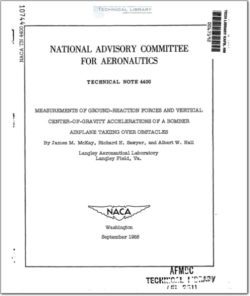NACA-TN-4400

- Version
- 154 Downloads
- 1.35 MB File Size
- 1 File Count
- March 24, 2016 Create Date
- March 24, 2016 Last Updated
National Advisory Committee for Aeronautics, Technical Notes - Measurements of Ground-reaction Forces and Vertical Center-of-Gravity Accelerations of a Bomber Airplane Taxiing Over Obstacles

An investigation was made on an unswept-wing four—engine bomber air-
plane to determine the vertical and drag ground-reaction forces imposed
on the landing gear when taxiing over obstacles 1.5 and 3.0 inches in
height and l, 2, and h feet in width. Vertical accelerations at the cen-
ter of gravity of the airplane and shock—strut displacement were also
measured. The investigation included a range of ground speeds from 10
to 70 miles per hour. The weight of the airplane was approximately
95,000 pounds. Results are presented of the effects of ground speed and
the widths and heights of the obstacles on the vertical and drag forces,
on vertical acceleration at the center of gravity of the airplane, on
shock-strut displacement, and on response of the upper mass of the air-
plane structure.
The results of the investigation indicate that maximum incremental
vertical and rearward drag ground-reaction forces are primarily a func—
tion of the height of the obstacle. The maximum incremental vertical
ground-reaction force for each obstacle height tested was the greatest
for the 2- and h—foot widths and the smallest for the l-foot width. The
mathhn rearward drag ground—reaction force for each obstacle height
tested was the greatest for the l—foot-wide obstacles and the smallest
for the h-foot-wide obstacles. The maximum incremental shock-strut com-
pression was greatest for the 5.0-inch—high_dbstacles and increased with
obstacle width for both the 1.5— and 5.0—inch-high obstacles.
The ground—reaction forces imposed on the main-landing-gear wheels are not
affected because the nose wheel strikes the obstacles first. The center—
of-gravity vertical acceleration of the airplane was the highest for the
2— and h—foot-wide obstacles for both the 1.5— and 5.0-inch heights
tested. The dynamic response factor at the center of gravity of the air-
plane, as a result of taxiing over any of the obstacles tested at speeds
above 25 miles per hour, reached values as much as twice the mean value
of 1.0 obtained in some previous landing tests at vertical velocities
up to about 5.5 feet per second. These higher values of dynamic response
factor obtained in the obstacle tests appeared to be associated with
higher force—input rates which, at the higher speeds, reached values
over three times the force-input rate obtained in the previous landing
tests.
| File | Action |
|---|---|
| naca-tn-4400 Measurements of Ground-reaction Forces and Vertical Center-of-Gravity Accelerations of a Bomber Airplane Taxiing Over Obstacles.pdf | Download |

Comment On This Post